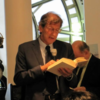Una tragedia ridicola
While the world-wide success of Roberto Saviano’s Gomorra brought us directly into the dark heart of Naples’ Camorra, Francesco Durante’s Scuorno offers an enlightened and enlightening brief introduction into the cultural mindset of Neapolitan culture.
Durante, born on the island of Capri, has made a living as a musician, translator,editor and professor of literature, and is known in Naples as a journalist and the editor of the works of Domenico Rea while in the United States he is perhaps better known as the author of the monumental, two-volume project Italoamericana: Storia e letteratura degli italiani negli Stati Uniti.
The catalyst for this book, and Durante’s point of departure, is the recent crisi dell’immondizia oppure, per i napoletani “a munnezza.” Italians around the world were embarrassed to see images of mountains of garbage fermenting in the streets of Naples with the obligatory panoramic images of Vesuvius or the Bay of Naples in the background. No less than the prime minister, Silvio Berlusconi, took it upon himself to “solve” the crisis, promising to move the government to Naples until the emergency was resolved. As Durante points out, thinking of deep-rooted structural problems as “emergencies” has been a particular feature of the Neapolitan consciousness.
Durante begins his book with a lament: “Siamo stati la città dell’ultima epidemia di colera in Europa (1973). Quella del terremoto (1980). Quella delle ricorrenti faide di camorra . . . . Ora, dell’immondizia.” This led him to reflect on Naples, Neapolitans and Neapolitan history using sociology, anthropology, architecture, engineering, geography and politics. Naples and the Neapolitans have always occupied a unique place in the mental topography of Italians and other Europeans. For every Goethe who delighted in the aesthetics of the city (“non sarà mai del tutto infelice chi può ritornare col pensiero a Napoli”), there was someone such as Auguste Creuzé De Lesser who in 1806 wrote, in his Voyage en Italie et en Sicile “L’Euope finit à Naples et meme elle y finit très mal.” (Which Durante uses as the epigraph for this book.) Napoli, wrote Walter Benajamin, è veramente bellissima – vista da lontano. Insomma, Napoli è “il paradiso abitato dai diavoli.” To its credit, Naples is a living, breathing metropolis, not a theme park like Venice. È una città poliglotta e proteiforme.
Naples drowning in garbage is, for Durante, similar to the image of New Orleans literally drowning in the wake of Hurricane Katrina. But as in Saviano’s Gomorra, we discover that the Neapolitan are only partially responsible for the tragedy: much of the garbage that finds its way to Campagna comes from the north, from Lombardia and the Veneto, regions that pride themselves on their cleanliness and their lawfulness but which take advantage of another culture in the Mezzogiorno. Durante recognizes that the “disastro” as he calls it, “è lento, silenzioso, strisciante, diffuso. Come molte cose napoletane, non ha né capo nè coda, ed è perciò più difficile da governare.”
As with the Camorra, as with the corruption that followed the 1980 earthquake, aswith the cholera epidemic, the crisis works to confirm the worst stereotypes and deep-rooted prejudices about Naples including the supposed ability of Neapolitans to live in chaos, but all this “induce all’ironia, al sarcasmo, e anche al riso. Una tragedia ridicola insomma, e quanto tale tipicamente nostrana.”
The Greek humus of Naples is never far from the surface. Chaos is the reigning deity and for Durante, the sympathetic figure of Antonio Bassolino, the center-left mayor of the city in the mid 1990s, was a figure in a Greek tragedy, a victim of hubris. The good citizens of Naples know full well that the more things change, the more they remain the same. The writer Valeria Parrella comments that “prima magari ti accoltellavano per fame, ora lo fanno per prenderti il cellulare.” And yet they remain; or, if they leave, as did Durante (twice) they return. “Lontano a Napule, non si po’ sta” says the song.
Here there are thoughts on the Neapolitan dialect, the popularity of the presepe, women, transvestites, sex and religion: besides San Gennaro the city has 51 patron saints, leading Durante to conclude that it was not the Angiovins, the Bourbons, the French or the Spanish who molded the Neapolitans, but the priests.
A great delight is Durante’s meditation on the miracles (or failures) of San Gennaro (“ineffabilmente incomprensibile”), the Socratic dialogues with friends about the city, the mania for the lotto and dream interpretation, and the reminders of the works of Raffaele La Capria, Domenico Rea, Erri De Luca, Anna Maria Ortense, Giambattista Basile and even Giacomo Leopardi’s Zibaldone.
The book ends with the enduring and delightful image of a small statue of Pulcinella, that indomitable Neapolitan, on a spaceship orbiting the earth. To find out how he got there and his fate, the reader should read this book.
Stanislao G. Pugliese is professor of history at Hofstra University and the author of “Bitter Spring: A Life of Ignazio Silone”
---
Francesco Durante, Scuorno (Vergogna) Milan: Mondadori, 2008. 211 pp, € 17.50.










































i-Italy
Facebook
Google+
This work may not be reproduced, in whole or in part, without prior written permission.
Questo lavoro non può essere riprodotto, in tutto o in parte, senza permesso scritto.